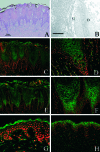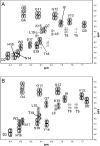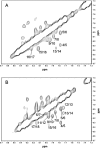A novel N14Y mutation in Connexin26 in keratitis-ichthyosis-deafness syndrome: analyses of altered gap junctional communication and molecular structure of N terminus of mutated Connexin26
- PMID: 16877344
- PMCID: PMC1698798
- DOI: 10.2353/ajpath.2006.051242
A novel N14Y mutation in Connexin26 in keratitis-ichthyosis-deafness syndrome: analyses of altered gap junctional communication and molecular structure of N terminus of mutated Connexin26
Abstract
Connexins (Cxs) are transmembranous proteins that connect adjacent cells via channels known as gap junctions. The N-terminal 21 amino acids of Cx26 are located at the cytoplasmic side of the channel pore and are thought to be essential for the regulation of channel selectivity. We have found a novel mutation, N14Y, in the N-terminal domain of Cx26 in a case of keratitis-ichthyosis-deafness syndrome. Reduced gap junctional intercellular communication was observed in the patient's keratinocytes by the dye transfer assay using scrape-loading methods. The effect of this mutation on molecular structure was investigated using synthetic N-terminal peptides from both wild-type and mutated Cx26. Two-dimensional (1)H nuclear magnetic resonance and circular dichroism measurements demonstrated that the secondary structures of these two model peptides are similar to each other. However, several novel nuclear Overhauser effect signals appeared in the N14Y mutant, and the secondary structure of the mutant peptide was more susceptible to induction of 2,2,2-trifluoroethanol than wild type. Thus, it is likely that the N14Y mutation induces a change in local structural flexibility of the N-terminal domain, which is important for exerting the activity of the channel function, resulting in impaired gap junctional intercellular communication.
Figures










References
-
- Kelsell DP, Dunlop J, Hodgins MB. Human diseases: clues to cracking the connexin code? Trends Cell Biol. 2001;11:2–6. - PubMed
-
- Rabionet R, Lopez-Bigas N, Arbones ML, Estivill X. Connexin mutations in hearing loss, dermatological and neurological disorders. Trends Mol Med. 2002;8:205–212. - PubMed
-
- Maestrini E, Korge BP, Ocana-Sierra J, Calzolari E, Cambiaghi S, Scudder PM, Hovnanian A, Monaco AP, Munro CS. A missense mutation in connexin26, D66H, causes mutilating keratoderma with sensorineural deafness (Vohwinkel’s syndrome) in three unrelated families. Hum Mol Genet. 1999;8:1237–1243. - PubMed
-
- Richard G, White TW, Smith LE, Bailey RA, Compton JG, Paul DL, Bale SJ. Functional defects of Cx26 resulting from a heterozygous missense mutation in a family with dominant deaf-mutism and palmoplantar keratoderma. Hum Genet. 1998;103:393–399. - PubMed
Publication types
MeSH terms
Substances
LinkOut - more resources
Full Text Sources
Medical
Miscellaneous

